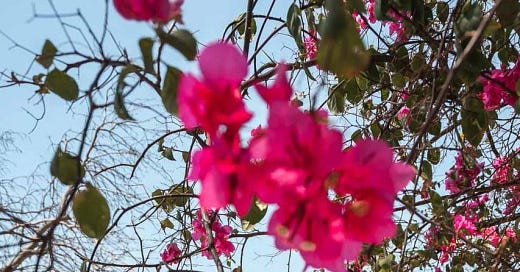Hola Global Jigsaw,
In Spain we are entering deep summer and everyone is heading off to the beach. So, I thought I’d post a classic travel piece for this week - introducing you to Lombok in Indonesia, the less well known, fraternal twin of Bali. I had posted a piece in the Global Jigsaw over a year ago about an annual food fight that takes place in Lombok between its Hindu and Muslim communities. A ritual that gave me both cause for hope and despair. You can read that piece here.
For today, its lighter fare. Read on to be transported to a land of molten skies, strawberry mojitos and infinity pools.
An excerpt from this post is free to all readers, but for access to the entire piece please do upgrade to a paid subscription. You will have my eternal thanks and a weekly shot of global views - in both senses of the world :-) As well as personalised advice on travel via email, should you want it.
***
Within minutes of leaving Lombok’s airport behind, it beame apparent why this southern Indonesian island’s reputation as the “un-Bali” is well deserved. Instead of Bali’s high-octane, traffic-clogged thoroughfares, our taxi meandered along two-lane byways flanked by paddy fields whose green seemed to burst out at you. We spotted the occasional conical straw hat bobbing in the distance, as a farmer waded across the vista.
Photo credit: Valerie
“How do you like the Lombok Ferrari?” our taxi driver joked, as he tooted his horn at an oncoming horse and carriage.
Only a half-hour flight from the Hindu enclave of Bali, Lombok is a Muslim-majority island. Instead of the swirls of incense smoke and offerings of flowers and food that dot the typical Balinese village, it is a succession of mosques that thread the landscape in Lombok. “We have 1,000 mosques on the island,” our chatty driver beamed. The mosques we passed looked newly built. Many were fronted with shiny white bathroom tiles.
Little is known about Lombok prior to the 17th century except that it was settled by a group of animist farmers called Sasaks, who migrated south from either Burma or North West India. The Sasaks converted to Islam between the late 16th and 17th centuries, but were soon after conquered by the Hindu Balinese kingdom of Gelgel.
As a result, many of the island’s Muslims adhere to a syncretic mix of Islamic, Hindu-Buddhist, and animist beliefs, known as Wektu Telu. The mosque building that was so in evidence as we drove towards the hotel however, was indicative of the rise of a more strict, purist form of Islam. Nonetheless, there were other signs of the island’s historic pluralism. We passed Chinese graveyards filled with lacquered Taoist deities and a mechanics’ shop named Ramayana.
Our resort, was set directly on the island’s western sea front, a few minutes drive from the main tourist drag of Senggigi. It was a low-key, uncluttered area where the chief entertainment was the molten sky, as the sun set behind Bali’s volcanic, Mt Agung. We took in our first sunset while sipping strawberry basil mojitos, sprawled besides the resort’s infinity pool, the flaming horizon punctuated by the hulking silhouette of the volcano.




